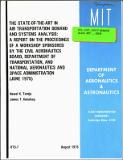| dc.description.abstract | Introduction and summary: Forecasting air transportation demand has indeed become a complex and risky business in recent years, especially in view of unpredictable fuel prices, high inflation rates, a declining rate of aggregate population growth, and an uncertainty with respect to the regulatory structure in the aviation industry. Since the stakes are very high, the need for accurate forecasting and for a more complete understanding of the total system of air transportation continues to grow. Past forecasting methods have become inadequate for at least two reasons. First, the trend extrapolation method of forecasting is no longer appropriate due to the significant changes in both the economic and the operating environments in recent years. Second, the more sophisticated econometric forecasting models are only as good as our understanding of the total air transportation system on the one hand, and the availability of data on the other. In light of these deficiencies, the dual needs for improving forecasting methods and for increasing the reliability of data are more critical now than ever before. In short, there is a compelling need to perform basic research to improve both the forecasting methods and the data in the aviation industry. Among the various types of forecasts of aviation activity desired by the government agencies, the air carriers, the airframe and engine manufacturers, the airport authorities, and the financial community, one component that plays a critical role in long-range planning pertains to the future fleet requirements for the aviation industry. Forecast items needed with respect to future fleet requirements include types, configuration, ranges, and technologies of new aircraft so that the industry and government can coordinate their resources to maximize the interests of the producers, regulators and consumers of future air service. The National Aeronautics and Space Administration (NASA), with its twin missions of both aeronautics and astronautics, has been focusing its attention on the aeronautics component in recent years. In this overall responsibility, the Systems Study Division of NASA-Ames Research Center has as one of its main objectives the development of a better understanding of the civil air transportation system in the United States, with emphasis placed on the proper and timely application of new technology. In order to fulfill this objective, the division has a critical need for projections of the growth of demand and for the determination of the role of technology in the future growth of air transportation. Before undertaking an extensive research effort in the area of air transportation demand analysis and forecasting, NASA-Ames attempted to solicit the views of the industry and other government agencies at a one day informal meeting in San Francisco in December 1974. The meeting was attended by about twenty experts from the carriers, airframe and engine manufacturers, U.S. Department of Transportation, universities and NASA. The goals of this mini-workshop were three-fold: the first objective was to determine the ways in which the NASA-Ames Systems Study Division could play a supportive role in this area; second, it was essential to receive an informal endorsement from the industry and other government agencies; and third, it was necessary to determine the direction for the proposed research. This meeting concluded with a general agreement on a definite need for future research, with the belief that not only could NASA-Ames play a supportive role but, more important, that it could play a catalytic role. However, due to the limited participation in this one-day meeting and the assistance that the proposed research could have provided to a wide variety of users, a more extensive workshop was proposed at that time, possibly to be co-sponsored by other government agencies. Subsequent to the December 1974 meeting, further discussions with the U.S. Civil Aeronautics Board (CAB) and the U.S. Department of Transportation (DOT) resulted in a three-day workshop co-sponsored by the CAB, DOT and NASA. The reasons for the joint sponsorship by the CAB and DOT reflected a desire from these agencies to participate in the search for methodologies and information on the long-range benefits, problems and issues of technological advances in aviation and to assist NASA in deploying its funds on these matters in the most productive and efficient ways. The overall objectives of this workshop were four-fold: first, to investigate the state-of-the-art in air transportation demand forecasting; second, to determine the needs of the various government agencies and the industry; third, to assess the possibility of long-term government sponsorship of basic research to improve the forecasting of air transportation activity; and fourth, to determine the most promising areas of research in air transportation and systems analysis. This workshop was organized by the Flight Transportation Laboratory of the Massachusetts Institute of Technology and the Transportation Center at Northwestern University and was held at the Mayflower Hotel in Washington, D.C. on June 2-4, 1975. The meeting was attended by one hundred experts, thirty-three of whom made extensive presentations. This report then is a summary of the highlights of the presentations delivered at the workshop, with appropriate interjections and editorial comments as perceived by its authors. | en_US |
